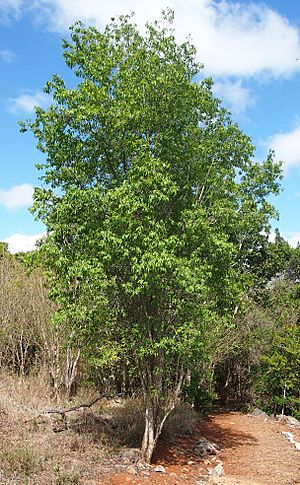Peach bush facts for kids
Quick facts for kids Peach bush |
|
|---|---|
 |
|
| Ehretia saligna var. membranifolia | |
| Scientific classification | |
| Genus: |
Ehretia
|
| Species: |
saligna
|
| Varieties | |
|
|
Ehretia saligna, also known as peach bush, native willow, or peachwood, is a type of shrub or small tree. It grows naturally in Northern Australia. You can find it from the Gascoyne region in Western Australia, across the Northern Territory, and throughout northern Queensland. It also grows in coastal parts of Southern Queensland and New South Wales.
This plant is special because it can grow in many different places, from wet rainforests to hot deserts. It also looks a bit different depending on where it grows. Because of these differences, people used to think there were two separate species. Now, scientists know they are just different types, or varieties, of the same plant.
Contents
What Ehretia saligna Looks Like
Ehretia saligna can be a shrub or a small tree. It often has a weeping shape, meaning its branches hang down. Its leaves are simple and narrow.
Flowers and Fruit
This plant produces small, green-white flowers, about 1 to 2 millimeters long. These flowers grow in clusters called panicles. You can usually see them in autumn or spring.
After the flowers, yellow or red fruits appear. These fruits are small, about 1 to 4 millimeters wide. Each fruit has two to four large seeds inside.
Edible Fruit
The fruit of Ehretia saligna is safe for humans to eat. It was a very important food source for Aboriginal Australians, especially in dry areas where other food might be scarce. Many types of birds also enjoy eating these fruits.
Where Ehretia saligna Grows
Ehretia saligna is amazing because it can live in so many different environments. You can find it in tropical rainforests, wet marshlands, and even hot desert regions. This ability to adapt is why it shows so much variety in its leaves, flowers, and how it grows.
Ehretia saligna var. membranifolia
One type, called Ehretia saligna var. membranifolia, is found in the Northern Territory, North Queensland, and coastal areas of Central Queensland, reaching down to northern New South Wales. This variety usually grows in wetter, more heavily wooded places. This includes monsoon forests, coastal rainforests, and the edges of lowland rainforests.
Because it grows in moister areas, this variety tends to be larger. It often grows as a small tree, up to 6 meters (about 20 feet) tall. Its leaves are wider, usually about four times as long as they are wide.
Ehretia saligna var. saligna
The other type, Ehretia saligna var. saligna, mostly grows in drier areas and open forests or woodlands. However, you might sometimes find it in monsoon forests too. This variety has a much wider range than membranifolia. It grows in coastal Western Australia and across both dry and coastal dry regions of the Northern Territory and Queensland.
While it can also reach 6 meters tall, this variety is more often seen as a shrub, usually 2 to 4 meters (about 6 to 13 feet) tall. Its leaves are much narrower, typically 8 to 10 times as long as they are wide.
Uses of Ehretia saligna
This plant is useful in several ways.
Food and Medicine
Besides the fruit being a food source for people and birds, Aboriginal Australians also used the wood. They would make a special liquid from the wood to help with pain relief.
Other Uses
Ehretia saligna is also a good plant for cattle and sheep to eat, especially when there isn't much other food during dry times. Even though it grows slowly, people sometimes plant it as a shade tree because of its nice foliage.
Images for kids


